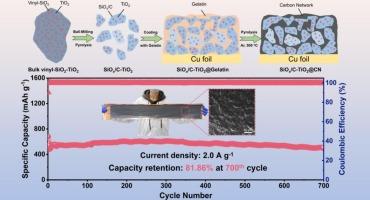Green synthesis of SiOx/C-TiO2 with continuous conductive network towards enhancing lithium storage performance
IF 8.9
2区 工程技术
Q1 ENERGY & FUELS
引用次数: 0
Abstract
High-capacity SiOx anodes face significant challenges in practical applications due to their low conductivity and high expansion rate. The combination of nanoengineering and carbon capping processes has been proven to address these issues. However, most carbon capping techniques cannot ensure uniform capping and fail to form a continuous conductive phase between active materials. This work proposes a green (solvent-free) and facile method for constructing SiOx/C-TiO2 (SCT@CN) nanocomposites by creating a three-dimensional carbon conductive network from gelatin-derived carbon and doping with titanium dioxide nanoparticles (TiO2 NPs). Comparison of TiO2 NPs with varying doping levels reveals that the synergistic effect between the conductive carbon network and TiO2 NPs enhances both the structural stability of batteries during charge/discharge cycles and the efficiency of active material utilization and lithium-ion diffusion. With the increase of TiO2 NPs, the capacity retention and ICE of the electrode improved, while the initial discharge capacity decreased. Notably, the SCT-2@CN electrode with 10 wt% TiO2 NPs exhibits the best electrochemical performance, with an initial coulombic efficiency (ICE) of 73.2 %. After 700 cycles at a high current density of 2.0 A g−1, it maintained a capacity of 503 mAh g−1, with a capacity retention rate of 81.86 %. The optimized carbon capping process and introduction of novel elements have the potential to enhance a range of energy storage materials.

绿色合成具有连续导电网络的 SiOx/C-TiO2 以提高锂存储性能
高容量氧化硅阳极由于导电率低和膨胀率高,在实际应用中面临着巨大挑战。纳米工程与碳封盖工艺的结合已被证明可以解决这些问题。然而,大多数碳封盖技术无法确保均匀封盖,也无法在活性材料之间形成连续的导电相。本研究提出了一种绿色(无溶剂)、简便的方法,通过明胶衍生碳创建三维碳导电网络并掺杂二氧化钛纳米颗粒(TiO2 NPs)来构建 SiOx/C-TiO2 (SCT@CN)纳米复合材料。对不同掺杂水平的 TiO2 NPs 进行比较后发现,导电碳网络和 TiO2 NPs 之间的协同效应既增强了电池在充放电循环过程中的结构稳定性,也提高了活性材料的利用率和锂离子扩散效率。随着 TiO2 NPs 的增加,电极的容量保持率和 ICE 均有所提高,而初始放电容量则有所下降。值得注意的是,含有 10 wt% TiO2 NPs 的 SCT-2@CN 电极表现出最佳的电化学性能,其初始库仑效率(ICE)为 73.2%。在 2.0 A g-1 的高电流密度下循环 700 次后,其容量保持在 503 mAh g-1,容量保持率为 81.86%。优化的碳封接工艺和新型元素的引入有望增强一系列储能材料的性能。
本文章由计算机程序翻译,如有差异,请以英文原文为准。
求助全文
约1分钟内获得全文
求助全文
来源期刊

Journal of energy storage
Energy-Renewable Energy, Sustainability and the Environment
CiteScore
11.80
自引率
24.50%
发文量
2262
审稿时长
69 days
期刊介绍:
Journal of energy storage focusses on all aspects of energy storage, in particular systems integration, electric grid integration, modelling and analysis, novel energy storage technologies, sizing and management strategies, business models for operation of storage systems and energy storage developments worldwide.
文献相关原料
公司名称
产品信息
阿拉丁
ammonia solution (NH3·H2O)
阿拉丁
TiO2 NPs
 求助内容:
求助内容: 应助结果提醒方式:
应助结果提醒方式:


